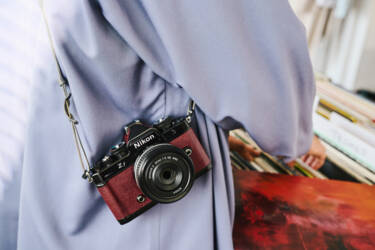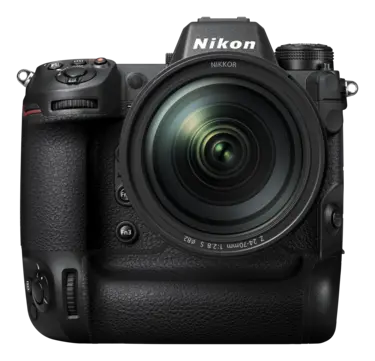Wildlife photographer Lina Kayser on building connections and photographing animal emotions with the Z 9

In the fifth instalment of our ‘What I’ve learned as’ series, the Norwegian Nikon Creator shares her greatest photography lessons, from building confidence to Instagram strategies
Lina Kayser is living the dream. Located in a spectacular lodge in the Dovrefjell-Sunndalsfjella National Park, Norway, the wildlife and nature photographer has wild reindeer, Arctic foxes, golden eagles and musk oxen at her fingertips. She runs her own photography workshops here and has been hosting ship-based expeditions to the wildness of the Svalbard archipelago since 2018. Chatting to Nikon magazine, the Nikon Creator shares her biggest lessons she’s learned over the last decade.
I wasn’t always a wildlife photographer
“I started out photographing dogs, then turned to nature and landscape,” Lina explains. “Photography genres are fluid, and it wasn’t until I received my first telephoto lens that I moved into wildlife.
“Growing up, I always had an interest in the outdoors, mainly thanks to my parents’ love of nature. I would go on hikes and just wished I could capture the sublime scenery. I then started borrowing my dad’s old Nikon DSLR. I was set on mastering the manual settings and spent time reading camera how-to books. I decided I wanted to learn the camera better than him!” Lina smiles.
After some time in the corporate world, Lina quit her office job and started a dog training school with friends in 2016. This, coupled with a photography workshop trip in Iceland, was the turning point in her career. After her Iceland jaunt, she came home with hundreds of photos and started posting on Instagram. “My Instagram just blew up,” Lina recalls. “In one year I had more than 80,000 followers.” She posted daily to remain active and interacted with other photographers on the platform.

Use social media to network
Building a social media following allowed Lina to build new contacts and plan photography workshops. “I wrote to Nikon asking for a partnership and they called me back saying they were interested,” she reflects. In 2017, she became a guest speaker and presented in a camera store in Stockholm about her career, in partnership with Nikon. This kick-started her new chapter as part of the Nikon family.
“I’d always recommend asking photographers on Instagram their camera settings and composition, so you can try them out yourself,” says Lina. “If I don’t know the area I’m photographing in well, I also find social media an easier way to find a local that could show me the best spots to photograph.”


The NIKKOR Z 100-400mm f/4.5-5.6 VR S is a versatile hiking lens
“The new NIKKOR Z 100-400mm f/4.5-5.6 VR S is a great, affordable wildlife and landscape lens to carry on a hike especially,” Lina says. “It’s super sharp and a great alternative to my AF-S NIKKOR 400mm f/2.8E FL ED VR (coupled with a Mount Adapter FTZ II) when I want a lighter option on my Nikon Z 9.”
On top of these lenses, Lina uses the NIKKOR Z 800mm f/6.3 VR S, NIKKOR Z 85mm f/1.2 S, NIKKOR Z 24-70mm f/2.8 S and the NIKKOR Z 40mm f/2. She also uses the Nikon Z 30 with the NIKKOR Z DX 16-50mm f/3.5-6.3 VR and takes images handheld without filters.
“The Z 30 is a great pocket camera for when I’m hiking and carrying other wildlife gear,” she explains. “It’s good for taking snapshots and video for Instagram Reels.”

Capture animal emotion above all else
“I always enjoy photographers making the very best of the gear they have,” Lina continues. “I sometimes hear people saying, ‘I can’t take a picture like you because I can’t afford the gear you have.’ But I started out with the D7000 and AF-S NIKKOR 50mm f/1.4G. Photography is a lot about having the eye for emotions, light and composition. It’s better to capture emotion than to be technically perfect. My best advice is to shoot in the early morning, when the sky is still pink, or at sunset. If it’s a full-day trip, get up early, scout the location and pack as light as possible.”
Beginners should start with Aperture Priority
Aperture Priority is a camera mode in which you can manually set your aperture, while the camera selects a shutter speed. Lina started with Aperture Priority, before going into full Manual. “I switched over to full Manual mode when I realised that I was arguing with the camera,” she says. “There’s no rush to dive straight into Manual.”

Build confidence at parks
“You can photograph just as much in cities and parks,” Lina explains. “It’s a great confidence-boosting exercise as urban animals are quite used to people so will stay still for longer.” For Lina’s guide to photographing the urban wildlife, read more here.
“In Norway, most animals are very shy, so I wear camouflage to blend into the environment and ensure there are no sudden movements or sounds,” she says. “I’d always suggest staying 200 to ten metres away at first (depending on animal and situation), to sit and observe the animals’ behaviour, and then get closer where possible and if it’s safe to do so.”
1/3000 shutter speed for fast-flying birds
“Try 1/3000 sec shutter speed or more for small, fast-flying birds or 1/2000 sec for bigger birds such as an eagle,” Lina advises. “For musk oxen, who move slowly, I don’t need a high shutter speed. You really have to feel the situation. How is the light? How is the weather? The animals? I like blurry bokeh in the background and foreground, so I always keep my aperture wide open.”

Have highlight warning on when photographing in the snow
“Snow can fool your camera sensor,” says Lina. “In my early days, I remember shooting and coming home to dark, grey images because of wrong exposure in my DSLR. With the EVF of a mirrorless camera, you can see the preview already, which is fantastic, but I recommend having your highlight warning on so you can set your exposure quite high –the camera will warn you if you’re blowing the highlights. Set the exposure up brighter than you think, then edit in post-production. I use Adobe Lightroom to edit, and I always suggest editing highlights, shadows and tones.”
Read more: Photographing winter landscapes – an advanced guide
What I’ve learned the most over the years is…
“When I was a child, I watched countless nature documentaries, and I always thought the shooting location was inaccessible or too expensive to visit, but there are so many places you can visit that is reachable or free,” says Lina. “You don’t have to sit in a forest all day. You can visit a hide or go on a trip with a local guide. There’s always someone you can get in contact with to help achieve your goals. If you can gain these connections, learn animal behaviour and learn how to approach animals ethically and safely, you’ll be well on your way to taking beautiful photos.”
Follow along on Lina’s adventures here.
Discover our ‘What I’ve learned as’ series
Featured products
More in wildlife and landscape
Ethical wildlife masterclass with Lara Jackson
Photographing winter landscapes — an advanced guide

For limitless creativity













